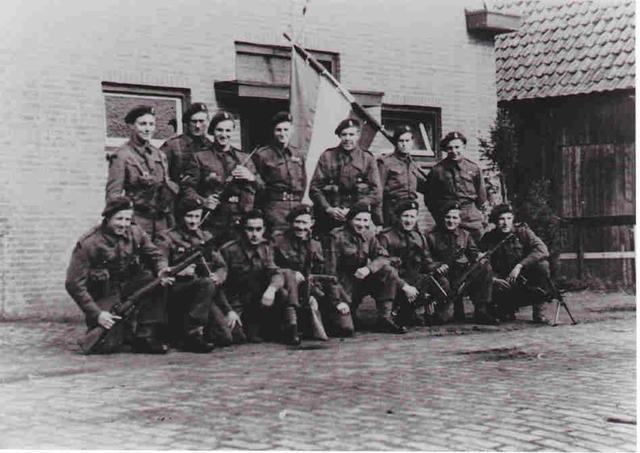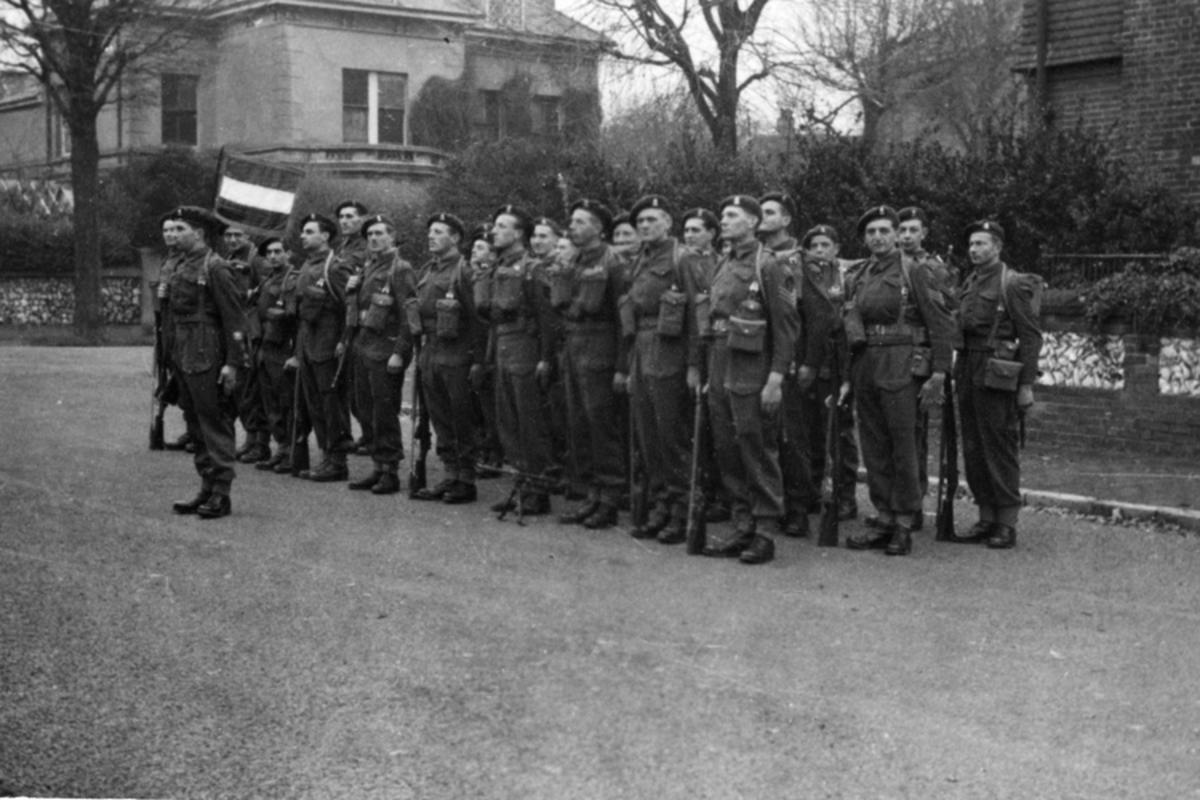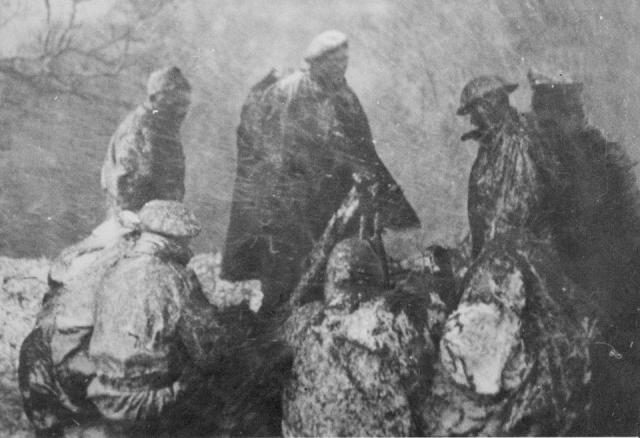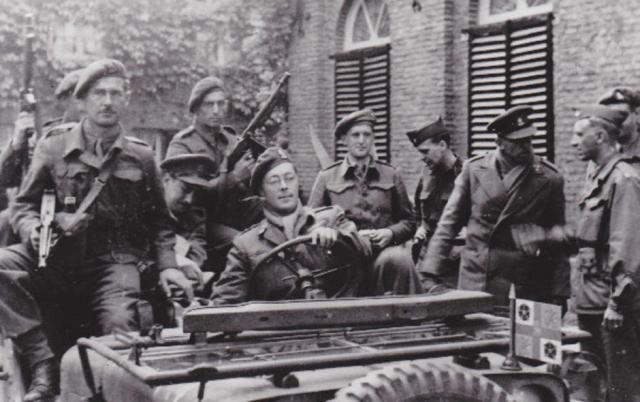2 troop (Dutch)
Primary tabs
2 Troop History
10th May 1940
Following Germay's attack on the Nederlands, some of the Dutch forces escaped and made it to Dunkirk to be evacuated to England to fight another day. A total number of 1.460 Officers and men were eventually to make it and were assembled in a tented camp in Haverfordwest, Pembrokeshire, South West Wales. They were soon joined by fellow countrymen from all over the world, plus more escapees from now occupied Holland.June 1940
The Dutch forces totalled more than 2,700 personnel which were quickly organised into a mobile Infantry Battalion Known as "Detachment Koninklijke Nederlands Troeper en Groot Brittania" under command of Gen.Maj. G.B. Noothoven Van Goor. The various international uniforms were replaced by the British Kahki and the Dutch Lion with word "Nederlands" underneath was worn on the left sleeve.January 1941
Queen Wilhelmina of the Netherlands confers the title " Koninklijke Nederlands Brigade Prinses Irene" (The Princess Irene Brigade) and in August the same year Queen Wilhelmina presented the Brigade Standard. Some of the Dutch soldiers would train as Commandos, others were selected for special training with the SAS and SOE. Those that could fly went off to form the Dutch arm of the Royal Air Force Troop. Finally a camp was built for the Dutch Bde at Wrottersley near Wolverhampton, now under command of Lt.Col A.C. de Ruyter Van Steveninck.March 22nd 1942
48 Dutchmen from the Koninklijke Brigade "Prinses Irene" (Princess Irene Brigade), are sent to No’s 3, 4, 9 and 12 Commando for pre-commando training.
May 1942
In May 1942 they attend the Commando Depot, Achnacarry, later renamed the Commando Basic Training Centre, for official Commando training. 25 of the original 48 pass the course.
June 29th 1942
Those who passed the Commando training move to Troon. There, 2 (Dutch) Troop was officially formed under command of T/Lt P.J. Mulders. At this time T/2Lt's., J. Linzel, M.J. Knottenbelt and C.J.L. Ruysch van Dugteren finished their officers training.
16 July 1942
The Dutch Troop moved to Porthmadog (Port Madoc), a town in northern Wales, to join No 10 (Inter-Allied) Commando under the command of Lt Col D. Lister as No 2 (Dutch) Troop. Numerous members of the Princess Irene Brigade go through Achnacarry to strengthen the Troop.
May 1943
Now based in Easbourne, the strength is five Officers, twelve NCO’s and 67 Other Ranks. Later that year the Troop is ordered to the Far East for action against the Japanese. Only five of them see action behind enemy lines in Arakan (Burma); some with No 44 Royal Marine Commando and some with No 5 Commando.
1944
The Troop is complete again and is, on their own request, sent back to Europe. Shortly after its return, the Troop receives orders to prepare for action on the mainland of Europe.
Arnhem
Sunday the 17th of September 1944, the Troop goes into action in the largest airborne operation of the Second World War: Operation "Market Garden". 12 Dutch Commandos are attached to various units of the First British Airborne Division. Two of them have to make a crash landing with a glider in Noord-Brabant en Schouwen-Duiveland. Four Commandos, one of whom is wounded, are taken prisoner during the fighting in and around Arnhem. After two attempts three of them escape the POW camp near Dresden in Germany and manage to reach US lines near the Tjech border. One of the troop, August Bakhuis Roozeboom, is killed in action during a courageous attempt to reach the bridge at Arnhem with a jeep full of ammunition.
Nijmegen
11 Dutch Commandos are attached to various units the 82nd (US) Airborne Division and three men are attached to the Headquarters of the First British Airborne Corps.
Eindhoven
5 Dutch Commandos are attached to the 101st (US) Airborne Division, where they give, in the words of a Regimental Commander, “invaluable assistance during the fighting.”
Five Commandos who are attached to the 52nd (Lowland) Division, which is to fly to Deelen airfield, join the HQ of the 1st British Airborne Corps after the battle.
On the 11th of October 1944 the remnants of the Troop assemble in Eindhoven. They are given the choice of taking some well earned leave or take part in the oncoming operation. They choose the latter!
In the meantime four Commandos are active in the occupied part of Holland. They belong to a group of eight Commandos who, on orders of the Dutch “Bureau Bijzondere Opdrachten” (SOE), are to give instruction on skill at arms and sabotage in the occupied part of Holland and to coordinate the resistance movement.
Three Commandos are serving as instructors to the so called “Stoottroepen” (a newly formed Dutch Army unit) in the liberated part of Holland.
Walcheren
1st of November 1944 No 4 Commando lands with a French Troop and 11 Dutch Commandos in the spearhead. On the evening of 3 November and after heavy street fighting in which two Dutch Commandos are wounded and where they also act as scouts and fulfill various special tasks, contact is made with the Commandos who have landed at Westkapelle.
Westkapelle
The landing at Westkapelle is carried out on the same day with 14 Dutch Commandos attached to No 47 Royal Marine Commando. Nine Dutch Commandos are wounded during the very heavy fighting around the German gun battery W2. The fighting was later described “as one of the fiercest battles of the whole operation”. On 3 November 1944 Walcheren is liberated and the route to Antwerp is free.In the meantime men are recruited in the liberated South of Holland to go through the commando training in Scotland. Of the 107 recruits who leave for Achnacarry on the 19th of November 1944, 72 manage to gain the green beret.
 They, together with other members of the Troop, are put into the line between Moerdijk and Geertruidenberg at the end of April 1945.
They, together with other members of the Troop, are put into the line between Moerdijk and Geertruidenberg at the end of April 1945.
Besides the 4 Commandos who are already in action as secret agents, another 2 Commandos are parachuted into the Veluwe and Drenthe at the start of April 1945.
After the liberation the Troop is for some time tasked to guard German prisoners of war in Recklinghausen.
28th June 1945
The Troop takes part in the Allied Liberation Parade in Amsterdam. Along both sides of the route from the Central Station, via the Rokin, the Dam and the Kalverstraat to the Museum Square, thousands of people line the streets, and give the Dutch Commandos a tremendous applause.
7th August 1945
Part of the Troop leave for England, where the main part of the men follow courses with the Royal Marines in Deal, in which they are trained as instructors for the newly forming Dutch Army.
October 1945
No 2 (Dutch) Troop is disbanded. Some are demobilized and resume their jobs in civilian life. Others are posted to the Stormschool Bloemendaal, a combat school to train soldiers for service in de Dutch East Indies. At the beginning of 1946 some twenty Commandos leave for the Dutch East Indies. Under their command and together with men from the Korps Insulinde (a Commando trained Dutch unit which operated from Ceylon against the Japanese), the Korps Speciale Troepen (Special Forces Regiment) and the School Opleiding Parachutisten (school for training paratroopers) is raised. They take part in many combat actions in the East Indies.
During the existence of No 2 (Dutch) Troop, four Commandos are killed in action and quite a few are wounded. Two are decorated with the highest gallantry medal, the Militaire Willemsorde, the equivalent of the Victoria Cross. Nine are decorated with the Bronzen Leeuw (Bronze Lion) and 27 with the Bronzen Kruis (Bronze Cross), all for gallantry in the face of the enemy.
[Source: Jack Bakker / Dutch Commando Museum.]
Follow this link for the Nominal Roll for No 10 Commando
Ask Questions / Add Information / Add Photos
Read some frequently asked questions here [FAQ's].






